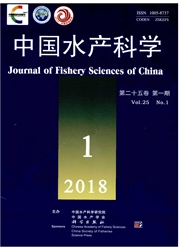

 中文摘要:
中文摘要:
为考察不同营养状况对鲤科鱼类偏好游泳速度的影响,本研究以鲫鱼(Carassius auratus)为实验对象,(25±1.0)℃条件下设置3个不同营养状况实验组:对照组(禁食48 h)、饱食组(饱食)和饥饿组(饥饿14 d),将单尾实验鱼置于梯度流速选择仪(流速范围为11.86~65.45 cm/s,等距离划分为5个流速区域,从第一到第五流速区域流速连续增加)中拍摄1 h,采用Ethovision XT9软件分析视频资料并计算实验鱼在不同流速区域平均进入频次(F,次)、单次进入停留时间(T,s/次)和平均停留时间百分比(P_t,%)等流速选择行为指标。结果显示,对照组和饱食组的F值随水流速度上升而增加,对照组的T值不同流速区域间无差异(P〉0.05),而饱食组第三和第四流速区域T值均显著大于其他流速区域(P〈0.05),因此两实验组第三和第四流速区域的P_t均显著大于其他流速区域,其偏好游泳速度为20.12~41.30 cm/s。饥饿组流速偏好行为出现表型分化,I型实验鱼在第一流速区域P_t和T值显著大于其他流速区域(P〈0.05),各流速区域的F值均显著小于其他实验组(P〈0.05),故I型实验鱼的偏好游泳速度为11.86~15.18 cm/s。而II型实验鱼则与对照组相似,在第三和第四流速区域Pt均显著大于其他流速区域(P〈0.05),故II型实验鱼的偏好游泳速度为20.12~41.30 cm/s。结果表明,饱食不影响鲫鱼的偏好游泳速度,可能是饱食不影响鲫鱼的游泳能力所致,但饱食组在各流速区域间的出入频次减少而停留时间有所增加。饥饿后鲫鱼偏好游泳速度出现表型分化,I型实验鱼的偏好游泳速度降低,而II型实验鱼则无明显变化,I型和II型实验鱼偏好游泳速度的差异可能是由于在饥饿条件下二者能量节约和游泳功能维持的策略不同。
 英文摘要:
英文摘要:
Fish usually alter their swimming behavior to adapt to changes in food resources in their natural habitats. In this study, we investigated the effects of nutritional status on the preferred swimming behavior of the juvenile crucian carp (Carassius auratus). Three experimental treatment groups with different nutritional status were es- tablished: the control group (fasted for 48 h), the feeding group (fed to satiation), and the starvation group (starved for 14 days). The experimental fish were videoed individually with a hand-made device for determining the preferred water velocity: a 1.5 m long conical raceway in which the water speed gradually increased from 11.86 cm/s to 65.45 cm/s at (25±1)℃. The water velocity of the 1st, 2nd, 3rd, 4th and 5th waster velocity intervals were 11.86-15.18 cm/s, 15.18-20.12 crn/s, 20.12-27.91 cm/s, 27.91--41.30 era/s, 41.30-65.45 cm/s, respectively. The videos were analyzed with the Ethovision XT9 software, and several parameters were calculated in each water velocity interval: frequency(F), the average duration of stay(T), and the percentage of time stayed(Pt), F increased as the water velocity increased for both the control and feeding groups. T showed no significant variation across different water velocity intervals in the fasting group, whereas the feeding group displayed the longest T in both the third and fourth water velocity intervals. Pt was significantly higher in the third and fourth water velocity in- tervals than in the other intervaJs in both the control and feeding groups, and the preferred swimming speeds of both the control and feeding groups were 20.12-41.30 cm/s. Two distinctly different preferred swimming behav- iors were apparent in the starved group, which we arbitrarily designated the type I and type II preferred swimming behaviors. The type-I fish showed the largest Pt and T values in the first water velocity interval, which were sig- nificantly higher than those in all other intervals. However, the F of these fish
 同期刊论文项目
同期刊论文项目
 同项目期刊论文
同项目期刊论文
 The effects of caudal fin amputation on metabolic interaction between digestion and locomotion in ju
The effects of caudal fin amputation on metabolic interaction between digestion and locomotion in ju The effects of diel-cycling hypoxia acclimation on the hypoxia tolerance, swimming capacity and grow
The effects of diel-cycling hypoxia acclimation on the hypoxia tolerance, swimming capacity and grow The effects of constant and diel-fluctuating temperature acclimation on the thermal tolerance, swimm
The effects of constant and diel-fluctuating temperature acclimation on the thermal tolerance, swimm The effect of aerobic exercise training on growth performance, digestive enzyme activities and postp
The effect of aerobic exercise training on growth performance, digestive enzyme activities and postp The effects of caudal fin loss and regeneration on the swimming performance of three cyprinid fish s
The effects of caudal fin loss and regeneration on the swimming performance of three cyprinid fish s Hypoxia impairs the digestive advantage of individual southern catfish (Silurus meridionalis) with h
Hypoxia impairs the digestive advantage of individual southern catfish (Silurus meridionalis) with h Variations in temperature acclimation effects on glycogen storage, hypoxia tolerance and swimming pe
Variations in temperature acclimation effects on glycogen storage, hypoxia tolerance and swimming pe The effect of prolonged exercise training on swimming performance and the underlying biochemical mec
The effect of prolonged exercise training on swimming performance and the underlying biochemical mec Effects of stable and diel-cycling hypoxia on hypoxia tolerance, postprandial metabolic response, an
Effects of stable and diel-cycling hypoxia on hypoxia tolerance, postprandial metabolic response, an Integrating environmental variation, predation pressure, phenotypic plasticity and locomotor perform
Integrating environmental variation, predation pressure, phenotypic plasticity and locomotor perform The effects of hypoxia acclimation, exercise training and fasting on swimming performance in juvenil
The effects of hypoxia acclimation, exercise training and fasting on swimming performance in juvenil 期刊信息
期刊信息
